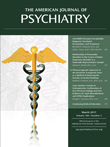T
o the E
ditor: We thank Dr. Torrey for the opportunity to clarify some points in our article (
1) about cultural trends in the stigma attached to mental illness. We begin by noting that we were neither perplexed nor un-perplexed by our findings. Dr. Torrey's interpretation represents a misconception about social science's contribution to understanding the issues surrounding mental illness. The goal was to bring empirical data to bear on common claims about the cultural trends in stigma and the implications for stigma reduction efforts.
From advocacy groups to the Surgeon General, a major line of thinking since World War II has involved the potential “power” of neuroscience to uncloak the biological/genetic roots of mental illness, thereby making it “a disease like any other” with the concomitant decrease in stigma. Our research grew out of our scientific curiosity and frustration with statements from important psychiatrists, including Dr. Torrey and the 2004 President of the American Psychiatric Association, Dr. Marcia K. Goin, that stigma had changed “in fact” with reasons “self-evident.” Often these statements were blatantly contradictory—stigma has increased because of deinstitutionalization or stigma has decreased because of deinstitutionalization. Our aim was simple and clear—issues of cultural context should be adjudicated through scientific research (in this case, by social science).
Culture is complex, making it important not to “cherry pick” findings. Yes, as Dr. Torrey points out, our research did indeed document an increase from the 1950s in spontaneous mentions of “dangerousness” in response to the open-ended question “What is mental illness?” (
2). But we also documented profound changes in people's willingness to disclose mental illness to family and friends (
3), to add chemical brain imbalances and genetics to the causes of stigma in mental illness while sometimes shedding notions of character flaws (
1), and to support greater help-seeking for such individuals from providers, including general practitioners, psychiatrists, psychologists, social workers, and counselors (
1,
3).
The role of perceptions of violence in stigma is not only plausible, but our research supports its association—we have not ignored the elephant in the room. But our research also shows that perceptions of violence are lower among those whose social networks include individuals with mental illness (
4,
5). Our analyses, here and elsewhere (
1,
5), do not suggest that linking violence to mental illness will lead to improved conditions for persons with mental illness, in the medical system, or in the community. Rather, as research has shown, public support for social assistance in health care systems is motivated by individual and national commitments to the public provision of services, not fear (
6).
We are not among those currently rejecting the use of the term stigma; like Dr. Torrey, we believe that only by talking about it, by researching its roots, and by the effectiveness of reduction efforts can we understand and gain the potential for change. Substituting one single-factor explanation (violence) for another (neuroscience) is not useful. Both represent the fallacy of the dramatic instance (
7), which somehow becomes uniquely attached to mental illness. The relative risk of violence associated with stigma in mental illness is no greater than that associated with male gender and youth. Yet the same societal reaction is not there. The tendency to overgeneralize in the case of mental illness is a problem; in fact, it is the mark of stigma (
8). Violence is not the only or the strongest correlate. There is more to stigma than violence and more to reducing stigma than simply getting people into treatment.
Social science can evaluate the state of cultural beliefs surrounding prejudice and the potential for discrimination, examining rather than assuming the forces of change underlying stigma. We were skeptical about pronouncements of either “change” or “no change,” just as we were skeptical about public acceptance of neuroscience as the panacea to reduce stigma. Our conclusion remains: It is time to rethink our efforts to improve the lives of persons touched by mental illness and to realize that neuroscience alone may not be the answer. Dr. Torrey may be certain that the underlying root of stigma is violence; we are not so sure.

